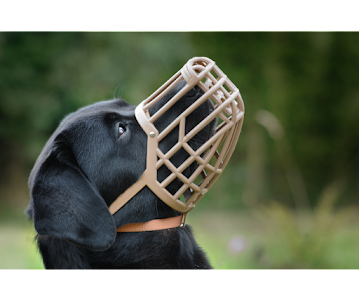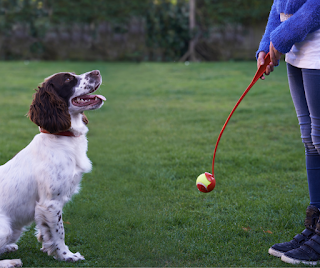6 Steps For Muzzle Training Your Dog
6 Steps For Muzzle Training Your Dog
There are several reasons why your dog may need to wear a muzzle. In fact, it's good practice to get any dog used to wearing a muzzle, even if it's not something they need to wear day-to-day. If your dog is reactive, teaching them to wear a muzzle in public places offers extra peace of mind that everyone is kept safe. Or, if they're an avid scavenger, a muzzle can be a useful management tool as part of their training.
Whatever the reason is behind your dog needing to wear a muzzle, they must be comfortable wearing one, and it shouldn't add any extra stress or anxiety for them. So, here is how to teach your dog to wear a muzzle successfully:
Step 1
Choose the correct muzzle for your dog. It should be a comfortable fit and allow your dog to pant freely while wearing it. This is essential for your dog's health and well-being. Never choose an 'occlusion' muzzle that firmly keeps your dog's mouth shut. This type of muzzle should only be used for very short periods or in emergency situations, never while your dog is exercising.
The Labrador pictured here is wearing a basket-style muzzle. This allows them to open their mouth to pant freely, without allowing them to bite or scavenge as freely as they could without one.
Step 2
Teach your dog to feel comfortable putting their nose and snout into objects. Try a mug, a glass, or a plastic or paper cup. Some dogs may not even be comfortable with these objects to start with. So, you could try teaching them to 'touch' a frisbee with their nose to begin with. Then, move onto a rubber ring before building up to the cup.
To do this, rub some dog-safe peanut butter, meat paste, cream cheese, or wet dog food on the base of the cup and let your dog lick it off. They will have to partially cover their snout with the cup to access the food reward.
This gets your dog used to the feeling of something being around their snout without it actually being a muzzle at this stage.
Although the dog in the photo has covered their whole face, the most important part of this step is to get your dog to willingly put their snout into the cup.
Step 3
Next, once your dog is fully comfortable with their snout being covered by a mug, you can repeat this step but this time, introduce the muzzle.
So, spread soft foods on the inside of your dog's muzzle and place the muzzle into the mug. This keeps the muzzle still, and the mug will also be familiar to your dog by now. So, they'll know what to expect.
If your dog is clicker trained, you can click and reward them each time they put their snout into the muzzle. This creates a double reward for your dog, the first when you click and give them a treat, and the second when they lick the food from the inside of the muzzle.
Once your dog is fully comfortable with choosing to put their snout into a muzzle, with it placed into a mug, you can move on to this step.
Take the muzzle in your hand and hold it still. Allow your dog to approach it and put their snout in to lick off the tasty treats again.
It's very important that you don't force your dog to put their snout into the muzzle, and that you don't move the muzzle towards your dog. It should be their choice to put their nose into it because without this, your dog may feel scared or uncomfortable.
It can also be beneficial to teach your dog to rest their chin in the palm of your hand. This reminds them that there is nothing to be scared of when things are touching their face.
Step 5
Once you are certain your dog is comfortable placing their snout into the muzzle, you can fasten it loosely for a few seconds, then remove it.
You can increase the duration gradually, provided your dog is comfortable with it.
If, at any point of this process, your dog shows signs of stress, you must stop the training and do something else your dog enjoys. You can then come back to muzzle training but make it easier for your dog to be successful this time.
Step 6
Your dog should now be happy wearing a muzzle that is fully fastened on them. So, now it's time to generalise your training to get your dog used to wearing the muzzle in different situations.
Practice your training in the garden, in your house, out on a walk, and in as many places as possible. Do it at different times of the day, in different weather conditions, etc, so your dog understands that it's okay to wear a muzzle no matter what is going on around them.
Play fun games and activities with your dog while they are wearing the muzzle, to make sure they know that their fun doesn't need to end just because of the muzzle! If their muzzle fits well, your dog should still be able to take treats from you or even pick up certain toys like a ball on a rope.
Your overall aim of muzzle training is to make sure your dog is completely comfortable and stress-free when wearing their muzzle. It's not as simple as putting a muzzle on your dog and waiting for them to get used to it. This will create stress and fear for them, which is not something we want to encourage.
Your dog should be able to live their life as freely in a muzzle as they would without one.
Putting in the groundwork with this training, to begin with, will set your dog up for success and ensure they are always comfortable wearing a muzzle. This trust and teamwork will only ever be beneficial to the relationship you share with your dog.
To find out more about helping your dog be as contented as possible, check out my book, Canine Contentment - The Essential Guide, which can be purchased here.








Comments
Post a Comment